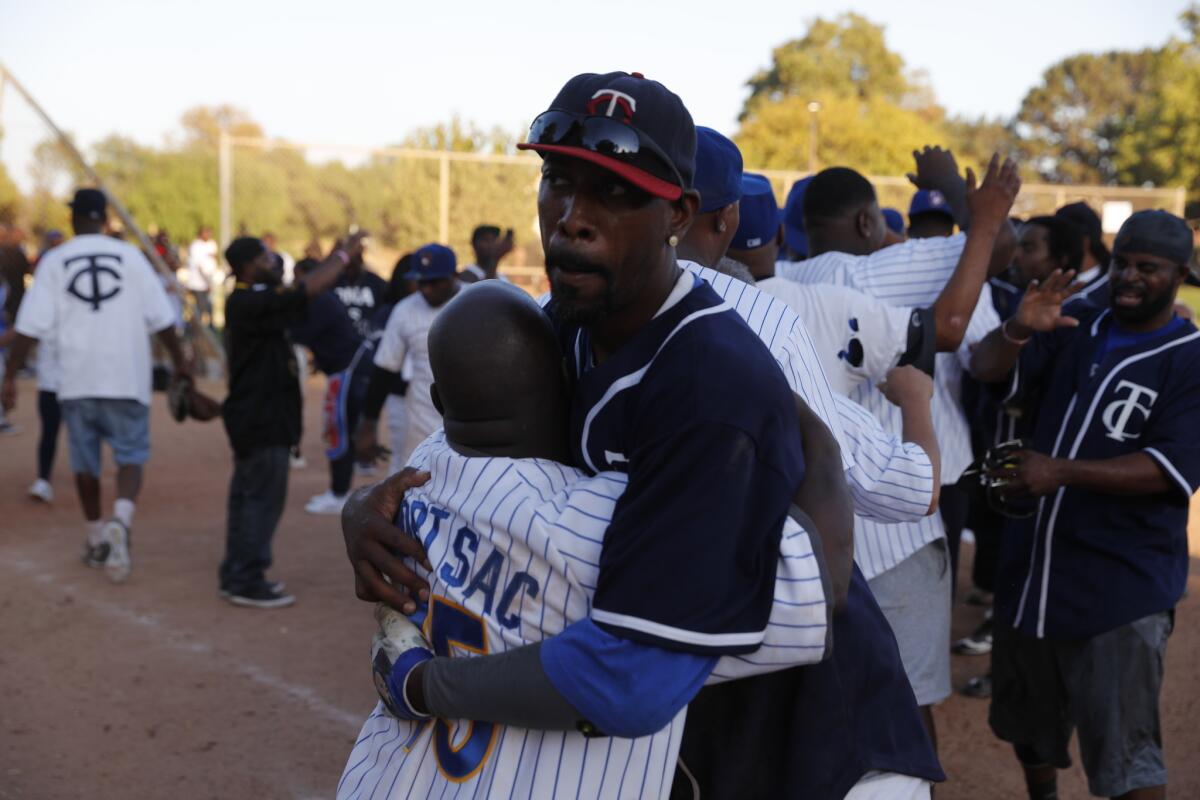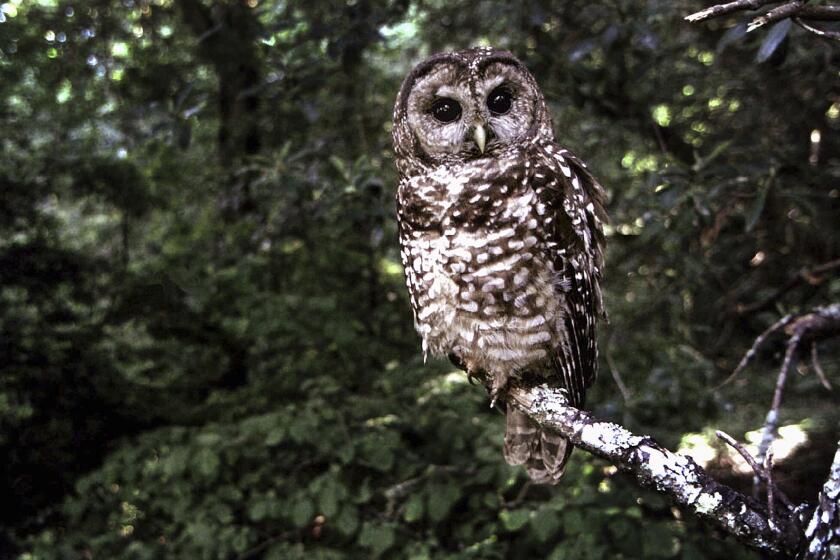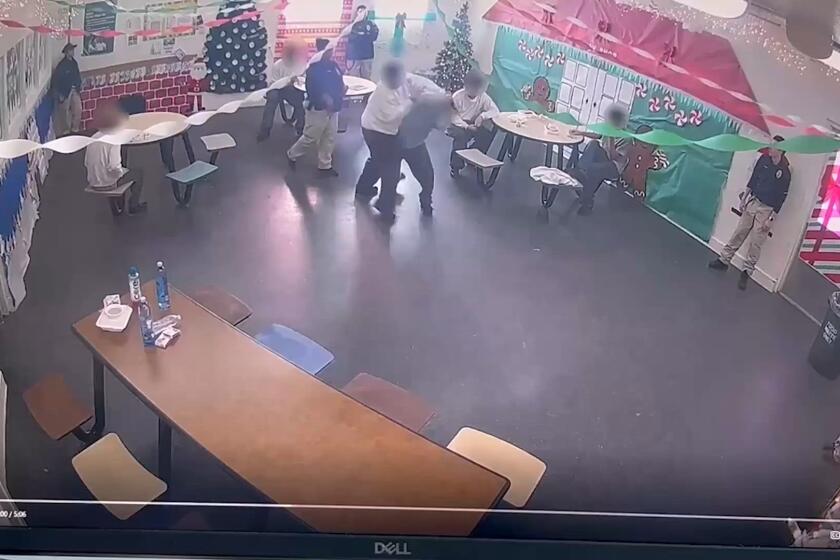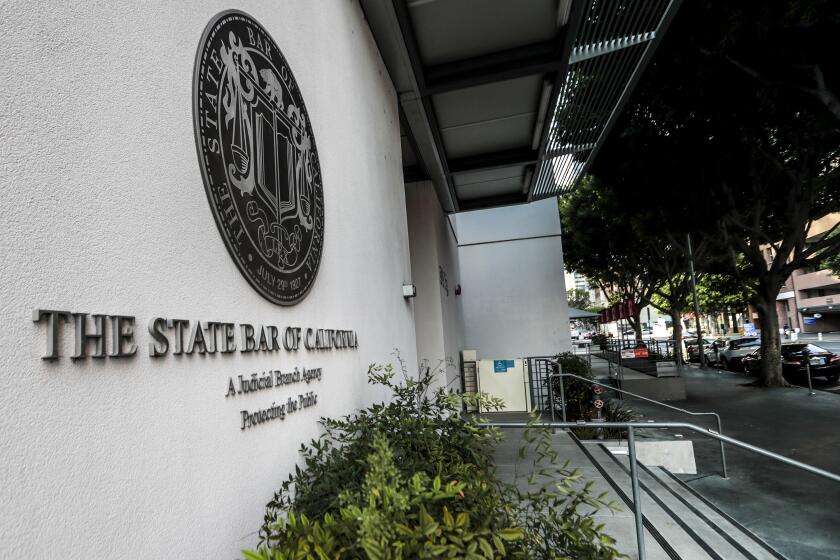Crips make peace on the softball field

- Share via
No one remembers exactly why the Ten Year War started.
Was it a fight at a Tupac Shakur concert? A dispute over a woman? After the first killing in the late 1990s, the cycle of revenge began.
In 2006, there was a truce. Now, on a cool Saturday in October, the two Crips gangs, once mortal enemies, were again battling for supremacy — not on the streets of Los Angeles, but in a softball league like no other.
The league’s eight teams wear uniforms that are predominantly Crips blue — never red. Jerseys are emblazoned with street names, some amusing — Shortsac, Casanova — and others, like Kill Kill, more ominous.
Many of the men have gone from hustling dope to working regular jobs. They have overcome bullet wounds, prison terms, the deaths of friends.
On game day, they savor the simple joys of swinging a bat, the thud of a ball in a leather glove, barbecuing with friends and family. They hope the youngsters who are watching will see how well their elders are getting along.
The hatred between Crips and Bloods is ingrained in popular culture. Less well-known are the alliances and enmities among Crips sets.
On the softball field, bygones are bygones. Even death is forgiven. The Rollin’ 30s Harlems and the Rollin’ 40s, combatants in the Ten Year War, had bested six other Crips teams to reach the championship. They greeted one another with hugs and trash talk about who would take over Martin Luther King Boulevard, the dividing line between their neighborhoods.
“Send it to 35th Street!” a spectator yelled as Lil C Moe of the 40s took a practice swing.
C Moe flied out, bringing his teammate Mizike across home plate for the first run of the game.
“Woo-ooh! Woo-ooh!” 40s supporters whooped their traditional neighborhood cry.
At every game, Reynaldo Reaser is a tightly wound presence, pacing the sidelines, making sure there is chalk for the diamond, that the teams arrive on time, that trouble does not break out.
For the most part, spectators know to leave their guns at home. But Reaser, a former leader of the Raymond Avenue Crips, can never be sure. One burst of violence, and the league, which Reaser started in 2016, could be finished.
As league commissioner, Reaser tolerates drinking and pot smoking while urging people to clean up after themselves and to be on the lookout for law enforcement.
Each week, he scrambles to book a park in the South Bay or Long Beach. He had hoped that games could be played at his gang’s home base, Helen Keller Park in West Athens. But L.A. County officials were leery of so many gang members gathering in one place.
He waits until the last minute to announce each week’s location. The more word spreads, the greater the chance that someone will arrive looking to shoot up an enemy. The teams in the league — the 30s, 40s, 90s, 100s, East Coasters, Raymond Avenues, Compton Nutty Bloccs and Compton Santanas — have fearsome reputations for violence.
“We always have the possibility of friction,” said Marcus Player, 58, a founder of the Raymond Avenue Crips who was released from prison in 2016 after serving more than 36 years for his role in an armed robbery in which the victim was fatally shot. “We’re still different Crips. We really didn’t know each other until we got on the field.”
Not all the softball players are gang members. Many are middle-aged and no longer make a living through crime. They still identify with their neighborhoods and their gangs — those loyalties practically run in their blood. But they want to use their influence to steer younger men away from the mistakes they made.
Charles “Bear” Spratley, who coaches the East Coast Crips, said he was lying in wait, ready to shoot a rival, when he had an epiphany. He had been in and out of jail all his life and survived being shot on nine different occasions. Now, he leads classes in local schools for students who are in detention or suspended.
“We’re doing it to teach the other dudes. We’re showing them you don’t got to get in no fight, no nothing,” said Spratley, 50. “Once it’s over, we go home.”
Each team appoints an “ambassador” to enforce the rules within his own gang, from the gun ban to steering away spectators who might cause trouble.
The ambassadors hone their peacemaking skills by hashing out issues at weekly meetings and attending a dispute resolution class led by a UCLA professor. They have become a tight-knit group who ring others’ cellphones if a conflict between younger gang members on the streets threatens to escalate, as when members of the East Coasters and 40s argued over a parking spot earlier this year.
Some credit the league with keeping violence down this summer by giving people something to do on Saturdays.
“I ain’t out there in the streets, causing trouble. I’m out here to play ball,” said Lindsey “Linzo” Hogan, 48, who plays for the Compton Nutty Bloccs. “The negative, the gangbanging — this ain’t about being bad.”
Only gangs that have patched up their beefs can join the league.
Ryan “Pookie Twin” James’ brother was killed three decades ago by someone from the 30s. He no longer holds a grudge.
“It took 15 years. Sometimes you’ve got to forgive,” said James, 45, who plays for the Rollin’ 90s and works as a security guard at Drew Middle School.
Umpires and field rentals are expensive. The $35,000 cost for the league’s first season was footed by the Pete Carroll Foundation as well as RACE, the gang intervention nonprofit where Reaser is executive director. The Carroll Foundation provided an additional $40,000 for this season.
Other Crips sets have expressed interest in joining. The Bloods have started their own fledgling softball league. A Crips versus Bloods World Series could be possible down the road, some say.
“With patience and talking to the right guys, within the next five years, you’re going to be seeing the largest enemy sets playing softball with each other,” said Alex Alonso, a gang researcher and adjunct professor at Cal State Long Beach.
Wayne Caffey, a veteran Los Angeles Police Department detective and gang expert, said the softball league is a promising development.
“This is what everyone is fighting for — to curtail gang violence. What better way than clean, recreational fun?” Caffey said. “These men are sick and tired of going to funerals for young folks, loved ones. When you’re tired, you do something different.”
One Saturday in September, as teams faced off at El Nido Park in Torrance, young men huddled around a game of street dice, tossing $20 bills onto the pavement. One man clutched a wad of $100 bills.
There was trouble on another front. Someone who had insulted one of the league’s gangs on social media showed up at the game.
Despite the volatile ingredients, the afternoon remained peaceful. But Reaser called off the next week’s games. Gambling in public could bring unwanted attention from police, and fights could break out among the participants. The ambassadors needed to remind their people not to bring street disputes to the ballpark, he said.
Gathered around a picnic table at Helen Keller Park a few weeks later, the ambassadors hashed out other concerns.
Maybe regular season games should be played simultaneously at different parks, so park officials wouldn’t be “tripping about us all being together,” Reaser said.
His suggestion was shot down. The whole point was for all the teams to be in one place, some said.
“We need a park that understands what we’re doing — making sure our youth ain’t going to jail, getting shot in our communities,” said Garry “Twin” Dorton, an ambassador for the 40s.
During a semifinal game between the 40s and the Compton Santanas at Helen Keller Park, a loud bang rang out, and people in the bleachers scattered.
Reaser strode through the crowd. “Shut it down! Everybody pack it up and leave!” he ordered.
Spectators threw half-cooked meat into coolers and hastily folded their lawn chairs.
The location and the high stakes of the playoffs had attracted a large crowd. A disagreement erupted between two spectators from the same gang, possibly over money, several ambassadors later said. A gun fell out of one man’s pocket and went off when it hit the ground.
The championship game would proceed the following week at a Torrance park.
“We can’t have none of that. It’s all internal,” Reaser said. “If you have a problem with your homies, don’t come here. It’s disrespect for us.”
Some called it the Battle of King Boulevard. Others likened it to a Dodgers versus Angels freeway series.
The 30s Harlems were coached by John “Loose” Williams, who missed most of the Ten Year War while serving time in Louisiana prisons for illegally possessing firearms. The guns were not his, he said.
He was 28 years old when he went in, 43 when he got out. He left his old lifestyle behind, finding work as a security guard.
“I made it to 50 years old,” he said. “I have friends who didn’t make it to 17, 18 or even 15.”
Williams’ team took the field in dark blue Minnesota Twins jerseys and hats, with the entwined “T” and “C” standing for either Twin Cities or Thirties Crips.
The players included Cleo “D-Mac” Calloway, who recalls the guerrilla-style tactics of the Ten Year War and now works cleaning up homeless encampments; Tamon “Bucc” Clark, a flashy dresser who is a vocal cheerleader for his team; and Cyn-City, one of the few women in the league, who can be counted on to pound several singles a game.
The 40s, last year’s champions, wore the Milwaukee Brewers’ white pinstripe jerseys. The team’s baseball mitt emblem resembles a hand making a “four” symbol.
Jevon “Lil C Moe” Cobb, who served six years in federal prison for a bank robbery and is now a caseworker at a homeless shelter, rounds the bases with lightning speed, bringing a Type A intensity to the game. Jerry “Twin 2” Dorton, identical twin to Garry Dorton, is a heavyset power hitter, as is Will Edwards, who left prison in 2014 after serving 26 years for aiding and abetting second-degree murder and now works as a housing coordinator for domestic violence victims.
By the ninth inning, the 30s were ahead by several runs.
“We only need three outs. Play the hardest you ever played,” D-Mac urged his teammates as they huddled.
A fly to center, a line drive into a fielder’s mitt, then another fly to center — the 30s had captured the Crips softball crown.
D-Mac popped open a bottle of champagne and sprayed his teammates. Players from both teams exchanged high fives, murmuring, “Good game, good game.”
Spectators jubilantly posed for photos with the trophy, flashing gang signs — an “H” for Harlem Crips, a circular hand motion for “Rollin’,” a three and a zero for 30s.
Berniel “Blue” Garrett, 34, played on the 40s team this season until he was grazed by a bullet in a robbery.
“I figure that 90% to 95% of us have made negative choices,” said Garrett, a carpenter who has served time for robbery and fleeing from a peace officer. “We’re always judged by our pasts.”
As night fell, the two teams barbecued and drank together, riffing on who owned the territory around King Boulevard, until Torrance police officers arrived to break up the party.
For more news on the Los Angeles Police Department, follow me on Twitter: @cindychangLA
Sign up for Essential California
The most important California stories and recommendations in your inbox every morning.
You may occasionally receive promotional content from the Los Angeles Times.








